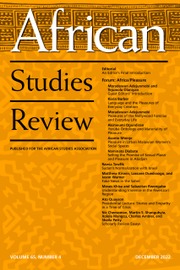A.G. Hopkins is an iconic figure in African studies and has been a leading scholar on the history of Nigeria. One has come to expect the highest standards of academic scholarship with Hopkins, and his latest contribution will not disappoint. He offers the reader an extended analysis of the development of capitalism in the non-Western world, and he brings this material to life by exploring the lives of 116 entrepreneurs who played important roles in the economic development of Lagos from 1851 to the 1930s. His work draws on the literature on port cities that shows how coastal regions served as transaction points in the evolution of the global capitalist economy into the twenty-first century. Essentially, Hopkins demonstrates how Lagos transitioned from a small fishing village in the early 1800s into Africa’s largest city.
Much of the research documented in this book, including interviews with leading families of Lagos, dates back to the early 1960s when Hopkins was collecting evidence for his doctoral dissertation. Some of the most insightful information in the book are the casual references to how life in Nigeria, as well as the field of African history, has changed during Hopkins’s lifetime.
Hopkins brings a level of self-awareness to this book that is deserving of respect; for instance, he suggests that his exhaustion of English-language sources, while comprehensive, may ignore other information that could affect the scope of his undertaking. A reader might wonder whether his focus on the economic contributions of the Saro community in Lagos (freed slaves transported from Sierra Leone) is overstated and whether the role of freed slaves transported from Bahia in Brazil (locally known as the Aguda) might be equally significant especially in light of the many street names and Brazilian-style buildings existing on Lagos Island today.
The foundation stone of Hopkins’s project is a recognition that Lagos is uniquely situated at a natural breach in the lagoon system dotting the West African coastline. Multiple rivers drain into this lagoon from the interior of the region, allowing Lagos to open up West Africa to the rest of the world’s seaborne commercial traffic. When the global economy wanted slaves, Lagos was positioned to become the leading port in the trafficking of human beings. In the late nineteenth century when capitalists realized that palm oil could attract greater value, Lagos once again became the leading source of trade since palm oil and kernels were widely produced in the regions upriver. Even though the harbor at Freetown was one of the largest natural deep-water ports in the world, it lacked the productive hinterland that fed into Lagos. European traders relied on indigenous entrepreneurs to bring resources to Lagos and other port cities along the West African coast. These indigenous entrepreneurs are the primary subject of Hopkins’s research, in particular the Saro migrants from Freetown and the Yoruba around Lagos, since they were Christians and spoke English. Hopkins analyzes how the embryonic bourgeoisie in nineteenth-century African societies were deprived of their class development by the colonial authorities that promoted the rise of African nationalists that could manage capitalist linkages between Africa and the global capitalist economy (25).
Hopkins identifies three shocks to the economic environment around Lagos. The first occurred in 1851 when Britain decided to end the slave trade and, to this end, bombed the port of Lagos. The second shock came in 1892 when the British government chose to enlarge the Lagos colony by capturing territory in the hinterland to the north. This endeavor led to the creation of the colony of Nigeria in 1914. The third shock erupted with World War One, which ended British reliance on indigenous entrepreneurs while opening up Nigeria to larger corporate conglomerates based in London. Hopkins’s book is mostly a detailed accounting of each of these three shocks.
Hopkins offers Africanists numerous pieces to the puzzle that depict how colonialism undermined indigenous political empires. But Hopkins acknowledges that the role of the Brazilians (or Aguda) is a story that escapes his scrutiny. His one example from the Aguda community is Joao da Rocha who traded more extensively with the British. He separately identifies Joaquim Francisco Branco as a leading merchant active in the trade between West Africa and Bahia (332). Missing from this narrative was that da Rocha was a friend and business ally of Branco, who commanded a larger economic empire along the West African coast and was more influential among the Aguda.
Hopkins also overlooks the fact that the indigenous governing authorities of Lagos were agents of the Kingdom of Benin early in the time period under study. Treating the Kingdom of Lagos as a sovereign power, as British authorities originally did, misses some important nuances of the political economy of Lagos.
To be fair, the political repercussions of British capitalist interventions in Nigeria are not the focus of Hopkins’s work. His mission is to uncover how indigenous markets were captured by larger corporate entities under the guidance of British colonial authorities, especially the United Africa Company. Nigerian independence began a process of expanding nationalist participation in the global economy. Hopkins notes that in 1949, Nigerian merchants were responsible for only 5 percent of imports; by 1963, their share had risen to 20 percent (510). Today, the Nigerian entrepreneur Aliko Dangote is the richest black person in the world. Hopkins give us an enlightening understanding of how these transformations occurred.

